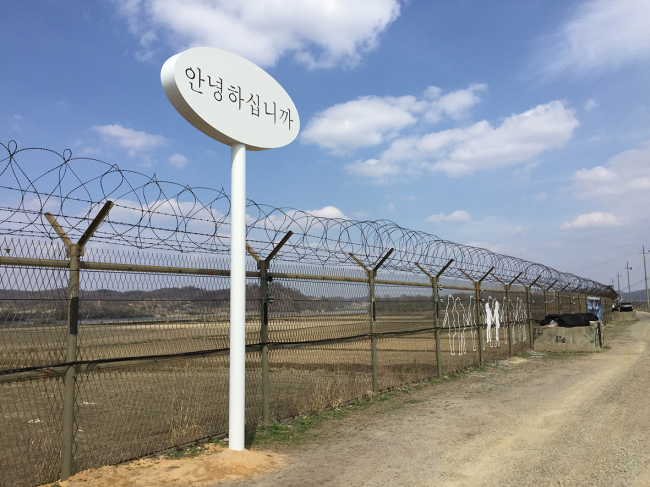Barbed wires become canvas for art
Artists exhibit artwork on fences guarding fortified inter-Korean border
By Lee Woo-youngPublished : April 23, 2015 - 20:02
PAJU, Gyeonggi Province ― Just a few kilometers south of the Demilitarized Zone runs a long line of barbed wire fences, separating the rice fields in the south and no-man’s land in the north.
Imjingang River also crosses the world’s most fortified border between South and North Korea. It is a tense and hostile area, with a man shot to death trying to cross to the Nouth in September 2013.
In this area, a white signpost reads “Hello” in Korean on both sides. Looking alien in its surroundings, the sign is, in fact, an art installation made by artist Yoo Young-ho. He is one of eight artists participating in “the LINE” art project being held in the Civilian Control Zone just south of the DMZ.
In its third year, the project, organized by the Gyeonggi Tourism Organization and the art agency “the Gonggam,” has commissioned artists to create artworks on the barbed wire fences. Most of the time, the area is closed for entry due to military operations and security and taking photos is strictly forbidden.
Imjingang River also crosses the world’s most fortified border between South and North Korea. It is a tense and hostile area, with a man shot to death trying to cross to the Nouth in September 2013.
In this area, a white signpost reads “Hello” in Korean on both sides. Looking alien in its surroundings, the sign is, in fact, an art installation made by artist Yoo Young-ho. He is one of eight artists participating in “the LINE” art project being held in the Civilian Control Zone just south of the DMZ.
In its third year, the project, organized by the Gyeonggi Tourism Organization and the art agency “the Gonggam,” has commissioned artists to create artworks on the barbed wire fences. Most of the time, the area is closed for entry due to military operations and security and taking photos is strictly forbidden.

The project started in 2013 with a small group of artists on a small section of the 4.9-kilometer-long fences. The artists covered the first 50 meters with art installations. The artworks were never taken down, and a relay of artworks has continued every year. They now cover some 400 meters on the fences.
“The wire fence is the symbol of hostility and division. I hope it transforms the image through the power of art,” said Hong Soon-pyo, president of the Gyeonggi Tourism Organization during the opening ceremony of the exhibition in Paju, on April 10.
“Each year, the line of wire fences decorated with artworks extended about 100 meters. I hope it continues until the North and South become united.”
The GTO began the project with a long-term goal to remove the image of hostility and tension of the border area and prepare for unification through the power of art.
Artworks on display carry messages of hope and reconciliation.
Artist Bahk Seon-ghi made a metal installation in the shape of a boy and a girl holding hands awkwardly as if it was their first time holding hands. Artist Na Jeom-soo also made two clasped hands carved from a rusty metal panel and engraved with the years 1945 and 2015. The year 1945 represents the year Korea was liberated from Japanese colonial rule, but the country was soon divided by the U.S. and the Soviet Union, which occupied the South and North, respectively.

“Relations between the North and South remain cold, but I think if we continue to hold our hands together, wouldn’t we all know each other’s mind?” said Bahk.
On one side of the wire fence hangs an edited photographic image featuring a symbolic image of the North and South division ― the image of the Joint Security Area, the only place where South and North Korean soldiers stand face-to-face.
The photo by artist Han Sung-pil features a lot of twists from the original photograph of the JSA. On closer inspection, one can find workers taking out the original sign board of the place “Panmunjom” and putting the new name “Unification Center.”
Instead of the plain blue wall, the exterior of the posts don beautiful murals from the artist’s previous photographs.
“I believe art has the power to heal us. I hope this work will change the reality of hostile division into hope for unification,” he said during the opening.
The area is open to a total of 300 civilians every fourth Sunday for a bike riding trip from March to October. The price for the trip is 10,000 per person and 3,000 for bike rental. Online registration is available at ggtour.or.kr.
By Lee Woo-young (wylee@heraldcorp.com)









![[Hello India] Hyundai Motor vows to boost 'clean mobility' in India](http://res.heraldm.com/phpwas/restmb_idxmake.php?idx=644&simg=/content/image/2024/04/25/20240425050672_0.jpg&u=)








